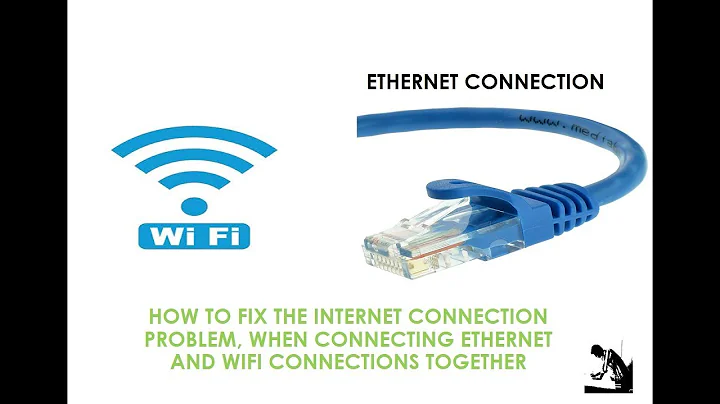Possible to have both Wi-Fi and Ethernet connected to the same network?
Solution 1
As you have found out, from the routing perspective, while possible, it is not ideal to have addresses from the same network in different interfaces.
Routing expects a different network per interface, and ultimately one of them will take precedence over the other in routing, since they overlap.
The advised solution for having more than one interface connected to the same network is to aggregate them together in a bridge interface.
The bridge interface will "own" the IP address, and the actual real interfaces are grouped as a virtual single entity under br0.
allow-hotplug eth0
iface eth0 inet manual
allow-hotplug wlan0
iface wlan0 inet manual
auto br0
iface br0 inet dhcp
bridge_ports eth0 wlan0
Debian Linux: Configure Network Interfaces As A Bridge / Network Switch
Solution 2
This is more an addendum than a complete solution. [Since I don't have enough "reputation points" to comment.]
You first have to make both interfaces work independently. Then, instead of bridging, you can also load balance outgoing connections across both interfaces.
https://www.tldp.org/HOWTO/Adv-Routing-HOWTO/lartc.rpdb.multiple-links.html
I started out with this, two devices with default route to the internet configured by network manager:
❯ ip route
default via 192.168.0.1 dev eno1 proto dhcp metric 100
default via 192.168.0.1 dev wlp4s0 proto dhcp metric 600
169.254.0.0/16 dev wlp4s0 scope link metric 1000
192.168.0.0/24 dev eno1 proto kernel scope link src 192.168.0.246 metric 100
192.168.0.0/24 dev wlp4s0 proto kernel scope link src 192.168.0.213 metric 600
Then I used the command, described here under load balancing:
https://www.tldp.org/HOWTO/Adv-Routing-HOWTO/lartc.rpdb.multiple-links.html
❯ P1=192.168.0.1
❯ P2=192.168.0.1
❯ IF1=eno1
❯ IF2=wlp4s0
❯ ip route add default scope global nexthop via $P1 dev $IF1 weight 1 \
nexthop via $P2 dev $IF2 weight 1
Voala! I get connections through both devices.
❯ ip route
default
nexthop via 192.168.0.1 dev eno1 weight 1
nexthop via 192.168.0.1 dev wlp4s0 weight 1
default via 192.168.0.1 dev eno1 proto dhcp metric 100
default via 192.168.0.1 dev wlp4s0 proto dhcp metric 600
169.254.0.0/16 dev wlp4s0 scope link metric 1000
192.168.0.0/24 dev eno1 proto kernel scope link src 192.168.0.246 metric 100
192.168.0.0/24 dev wlp4s0 proto kernel scope link src 192.168.0.213 metric 600
That might make debugging more difficult if I have connection trouble ;)
And I don't know how to persist the configuration across reboots yet, especially in combination with network manager.
Related videos on Youtube
rityzmon
Updated on September 18, 2022Comments
-
 rityzmon almost 2 years
rityzmon almost 2 yearsI am running Arch Linux (on a Raspberry Pi 3) and tried to connect both the Ethernet and the Wi-Fi to the same network.
routeshows me the following:$ route Kernel IP routing table Destination Gateway Genmask Flags Metric Ref Use Iface default gateway 0.0.0.0 UG 1024 0 0 eth0 default gateway 0.0.0.0 UG 1024 0 0 wlan0 192.168.1.0 0.0.0.0 255.255.255.0 U 0 0 0 eth0 192.168.1.0 0.0.0.0 255.255.255.0 U 0 0 0 wlan0 gateway 0.0.0.0 255.255.255.255 UH 1024 0 0 eth0 gateway 0.0.0.0 255.255.255.255 UH 1024 0 0 wlan0ip addrshows me the following:$ ip addr 1: lo: <LOOPBACK,UP,LOWER_UP> mtu 65536 qdisc noqueue state UNKNOWN group default qlen 1 link/loopback 00:00:00:00:00:00 brd 00:00:00:00:00:00 inet 127.0.0.1/8 scope host lo valid_lft forever preferred_lft forever inet6 ::1/128 scope host valid_lft forever preferred_lft forever 2: eth0: <BROADCAST,MULTICAST,UP,LOWER_UP> mtu 1500 qdisc fq_codel state UP group default qlen 1000 link/ether b8:27:XX:XX:XX:XX brd ff:ff:ff:ff:ff:ff inet 192.168.1.103/24 brd 192.168.1.255 scope global dynamic eth0 valid_lft 85717sec preferred_lft 85717sec inet6 fe80::ba27:ebff:fee4:4f60/64 scope link valid_lft forever preferred_lft forever 3: wlan0: <BROADCAST,MULTICAST,UP,LOWER_UP> mtu 1500 qdisc fq_codel state UP group default qlen 1000 link/ether b8:27:YY:YY:YY:YY brd ff:ff:ff:ff:ff:ff inet 192.168.1.102/24 brd 192.168.1.255 scope global dynamic wlan0 valid_lft 85727sec preferred_lft 85727sec inet6 fe80::ba27:ebff:feb1:1a35/64 scope link valid_lft forever preferred_lft foreverBoth
wlan0andeth0interfaces were able to get an IP address from the router.But it turns out that only one of these interfaces ever works. The other interface cannot be pinged and is not connectable. Usually it's the Ethernet that works but sometimes it's the Wi-Fi.
What's happening? What can I do to make this work?
-
Mikel about 7 yearsI assume IPv4? It works on my Ubuntu desktop after ARP starts working. What address are you pinging from? What address are you pinging? What does
arpshow on each side. What doestcpdump -i <interface> -v arpshow on all relevant interfaces on both sides? Can you get a packet capture on the switch/router? -
 rityzmon about 7 yearsYes, I'm using IPv4. I'm pinging192.16.1.103 and 192.168.1.102, the two IP addresses assigned.
rityzmon about 7 yearsYes, I'm using IPv4. I'm pinging192.16.1.103 and 192.168.1.102, the two IP addresses assigned. -
Mikel about 7 yearsFrom another machine on
192.168.1.0/24? Please addarpoutput to your question. -
Mikel about 7 yearsSee also lwn.net/Articles/45373
-
-
 Celada about 7 yearsBut still with the bridge, in most topologies, only one of them will wind up getting used because the other one will be shut down by spanning tree — or if spanning tree is turned off then you will have a devastating loop in the network.
Celada about 7 yearsBut still with the bridge, in most topologies, only one of them will wind up getting used because the other one will be shut down by spanning tree — or if spanning tree is turned off then you will have a devastating loop in the network. -
Rui F Ribeiro about 7 years@Celada They end up being a single entity, and work quite well. I have had such setup working for years to create a single entity out of my wireless and cabled network at home to be able to stream from wireless to my Apple TV (in the wired network), and it works beautifully.
-
Rui F Ribeiro about 7 yearsit talks stp by default, at home my switch is not smart enough to understand it.
-
AdminBee about 4 yearsWelcome to the site, and thank you for your contribution. Although it is not really an issue in this case where there is only one other answer, in general, please indicate the answer you are refering to in your post, as display order may depend on user settings. You can use the URL available via the "share" button below that answer to insert a link in your post.


![How to Use Ethernet and WiFi at same time in Windows 10 [Tutorial]](https://i.ytimg.com/vi/01yuzf578Yc/hq720.jpg?sqp=-oaymwEcCNAFEJQDSFXyq4qpAw4IARUAAIhCGAFwAcABBg==&rs=AOn4CLAkVPdQMXQUihwRC3JDGNgs2CwjkQ)

